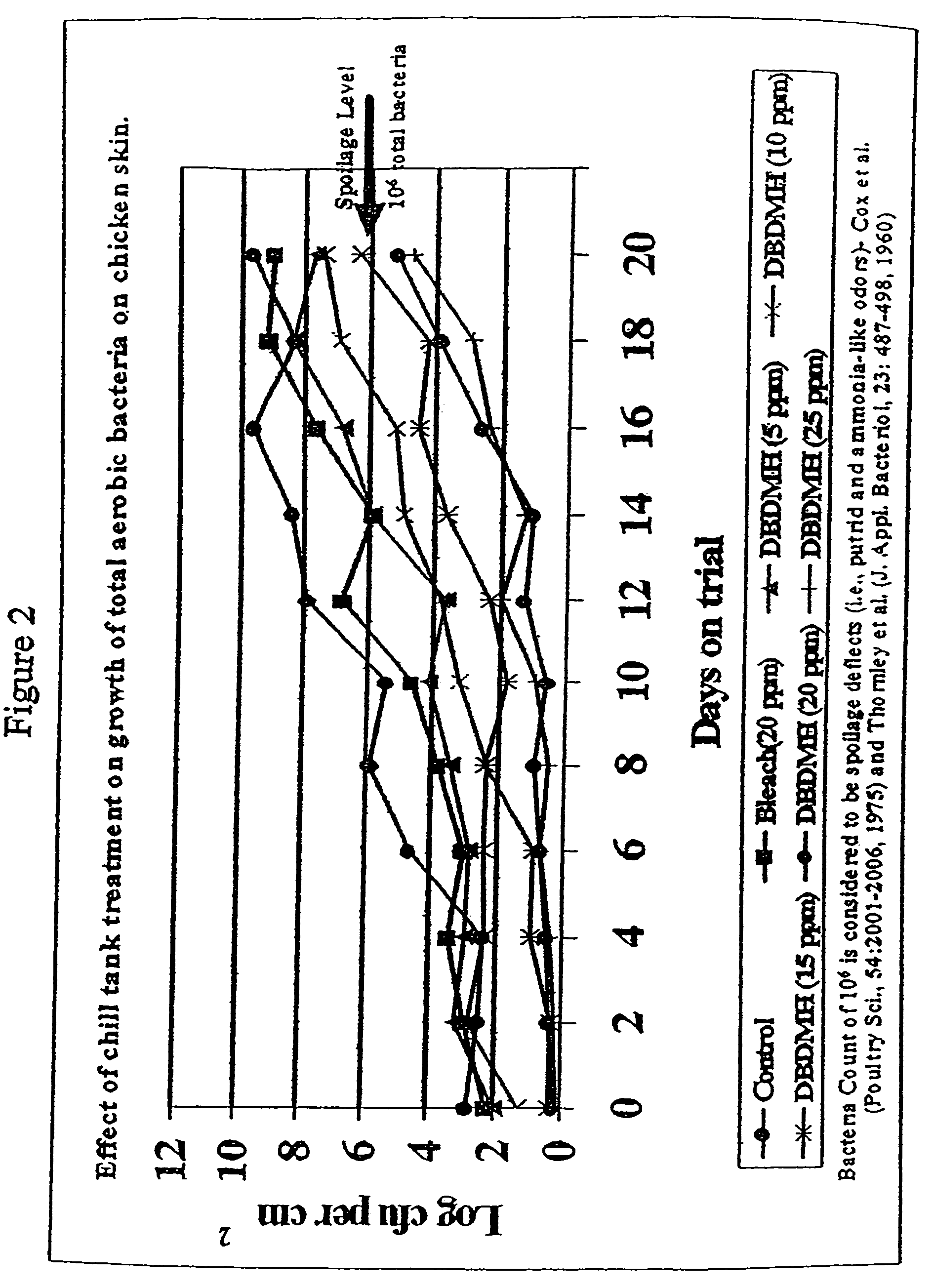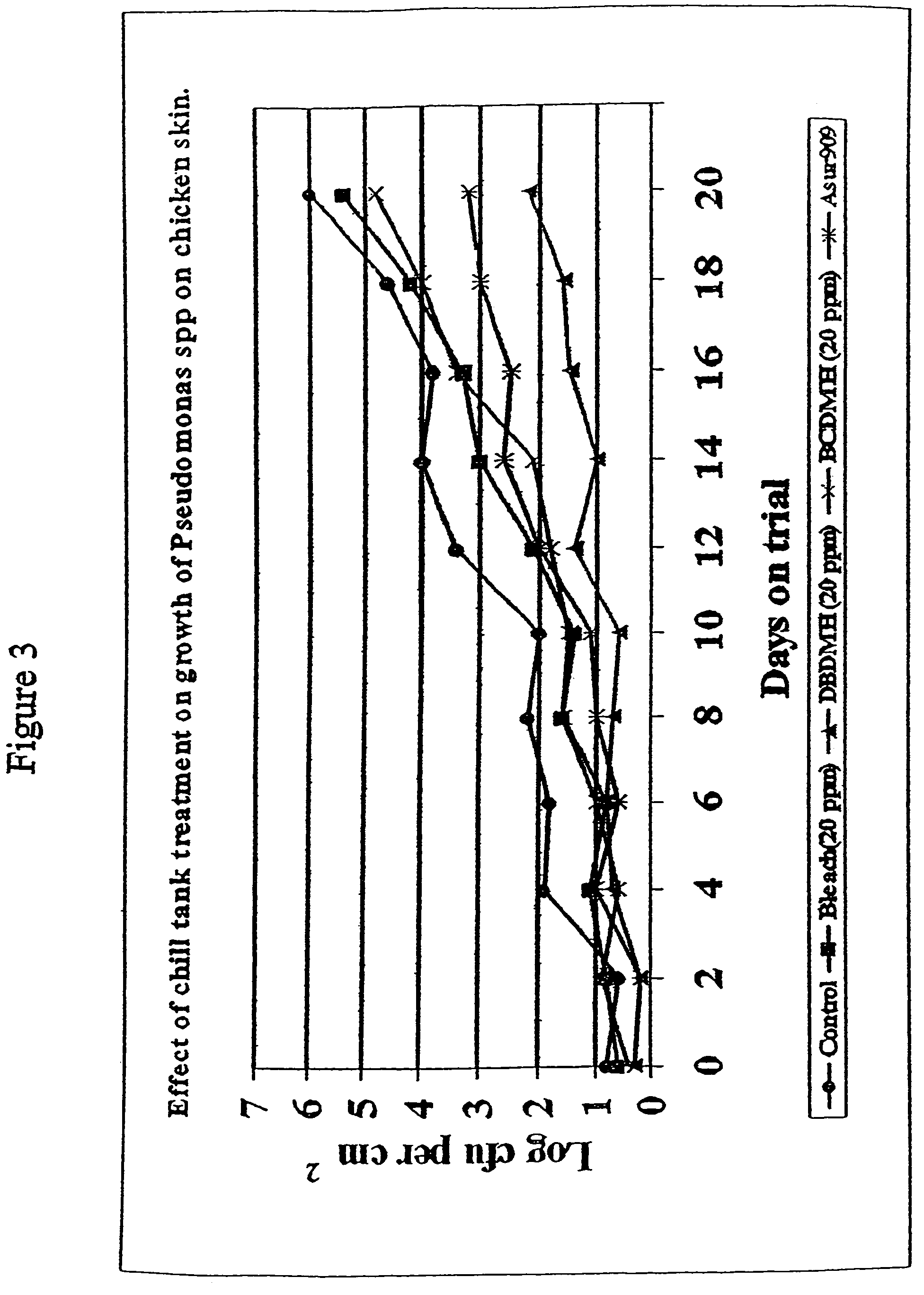Microbiological control in poultry processing
a technology for poultry and microorganisms, applied in the field of microorganism control in poultry processing, can solve the problems of difficult to find a way of effectively controlling a broad range of microorganisms encountered in such processing, and the extreme thought of handling, processing and consuming bacteria-infested poultry is revolting in the extreme, and achieves low cost and economic production.
- Summary
- Abstract
- Description
- Claims
- Application Information
AI Technical Summary
Benefits of technology
Problems solved by technology
Method used
Image
Examples
example 1
[0044]A study was conducted to determine the effectiveness of 1,3-dibromo-5,5-dimethylhydantoin (DBDMH) as a disinfectant, when used in the poultry chill tank for the control of carcass bacteria. The study included, for purposes of comparison, use of sodium hypochlorite as a disinfectant under the same conditions. In this study the bacterial species used were genetically marked strains resistant to several common antibiotics and antibacterials. Four treatment groups as identified in Table 1 were used in this study.
[0045]
TABLE 1TreatmentBr2 / Cl2 TargetGroup1Treatment2,3,5Concentration1Non-disinfected unchilled controlNoneNo disinfectant addedCarcasses spotted with 109 bacteriaCarcasses dried and immediately rinsed2Non-disinfected chilled controlNoneNo disinfectant added to chill tankCarcasses spotted with 109 bacteriaCarcasses dried, chilled, and rinsed3Sodium hypochlorite treatment4415 ppm Cl215 ppm Cl2 equivalent added to chill tank(+ / −20%)Carcasses spotted with 109 bacteriaCarcasse...
example 2
[0089]Comparative tests were conducted to determine the effect on poultry carcass bacteria (Escherichia coli field strain) during a normal 1.5-hour chill tank immersion in water containing different microbiocidal compositions. The effect of these treatments on the residual chill tank water was also investigated. Carcasses were first immersed in a warm bath containing 104 E. coli per mL of liquid. Carcasses were then immersed in chill tanks containing normal organic fluids (blood, fat, skin, and meat particles) and containing one of the respective microbiocidal compositions under test. Total bacteria count of whole bird (both inside and outside) was used to determine efficacy of various microbiocidal compositions. The microbiocidal compositions tested were sodium hypochlorite (Clorox® bleach), the combination of sodium hypochlorite and sodium bromide, and 1,3-dibromo-5,5-dimethylhydantoin, the first two materials being for comparative purposes. In this group of testes, 100 birds were...
example 3
[0096]This group of tests was conducted to determine the effect of Clorox® bleach, Aquatize® biocide, and 1,3-dibromo-5,5-dimethylhydantoin (DBDMH) on carcass bacteria (Escherichia coli field strain) residual after 1.5-hour in a chill tank “soup”. Tests were conducted with soups at pH 7, pH 8 and pH 9 (adjusted by trisodium phosphate) for whole bird bacteria counts. Tests at pH 8 were conducted for individual bacteria counts.
[0097]In general the tests involved normal processing of 56-day-old birds and immersing the carcasses first in a warm bath containing 104 per mL Escherichia coli, 104 per mL Salmonella enteritidis, 104 per mL Pseudomonas aeruginosa, 104 per mL Campylobacter jejuni, and 104 per mL spoilage bacteria each from three strains (Listeria monocytogenes and Shigella sonnei). The carcasses were then immersed in a chill tank “soup”, containing normal organic fluids (blood, fat, skin, and meat particles) and containing the microbiocides on the test.
[0098]Tables 7 and 8 summ...
PUM
 Login to View More
Login to View More Abstract
Description
Claims
Application Information
 Login to View More
Login to View More - R&D
- Intellectual Property
- Life Sciences
- Materials
- Tech Scout
- Unparalleled Data Quality
- Higher Quality Content
- 60% Fewer Hallucinations
Browse by: Latest US Patents, China's latest patents, Technical Efficacy Thesaurus, Application Domain, Technology Topic, Popular Technical Reports.
© 2025 PatSnap. All rights reserved.Legal|Privacy policy|Modern Slavery Act Transparency Statement|Sitemap|About US| Contact US: help@patsnap.com



